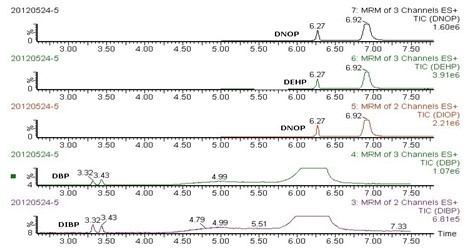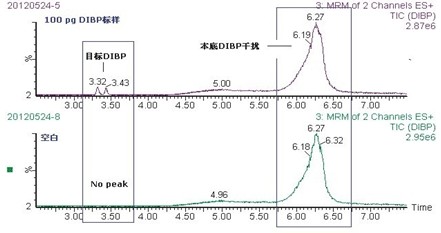——Use PFCs Isolator kit to solve the problem of background interference of plasticizer background
background
The importance of plasticizer testing is well-known, but the biggest problems and problems faced by users currently using LC or LC / MS to detect plasticizers are: There are several of the 17 illegally added plasticizers (such as DBP, DIBP, DEHP, DNOP, DINP, etc.) The background interference is very high. Due to the ubiquitous plasticizer in the environment and the interference from the analysis system itself, sometimes the background is as high as hundreds of ppb, resulting in the inability to qualitatively and quantitatively sample化 剂。 Chemical agent.
Analytical method
Experimental conditions
UPLC / Xevo TQD with PFCs Isolator kit
Column: BEH Phenyl 1.7μm 2.1x100mm
Injection volume: 2μL
Column temperature: 50 ℃
Flow rate: 0.5ml / min
Mobile phase: A: 0.1% formic acid in water B: 0.1% formic acid in acetonitrile
Mass spectrometer parameters
Ionization mode: ESI +
Electrospray voltage: 3.2kv
Desolvent gas temperature: 400 ℃
Ion source temperature: 150 ℃
Desolvation gas flow rate: 650L / hr
Experimental results
In the general analysis, we found that due to the relatively high system background of plasticizers (such as DBP, DIBP, DEHP, DNOP, etc.), it will lead to the inability to carry out accurate qualitative and quantitative work. The UPLC system equipped with PFCs Isolator kit can completely separate the interference plasticizer in the system background from the target plasticizer analyte in the sample, ensuring the accuracy of qualitative and quantitative analysis results.
 Figure 1. Plasticizer standard sample analysis TIC diagram.
Figure 1. Plasticizer standard sample analysis TIC diagram.  Figure 2. TIC diagram analysis of DIBP.
Figure 2. TIC diagram analysis of DIBP. PICs (product ion confirmation scan function) qualitatively confirmed the background interference
Using the PICs function of the Xevo series mass spectrometer and the TargetLynx software in MassLynx, you can compare the PICs mass spectrum of the actual sample collected with the standard PICs reference mass spectrum. The Forward Fit and Reverse Fit values ​​calculated by the software are quantitative Judgment of the matching degree of the sample and the standard product, so as to achieve qualitative confirmation.
Taking DBP as an example, the qualitative confirmation function of PICs is used to verify that the DBP in the system background has been completely separated from the DBP chromatogram in the sample.
in conclusion
This method solves the problem of background interference of the plasticizer system, making the background interference completely chromatographically separated from the target plasticizer analyte, and also achieves the baseline separation effect for DBP and DIBP isomers, ensuring its quantification Accuracy and qualitative accuracy. Using the unique PICs function of the Xevo series mass spectrometer, the product ion confirmation scan results can be obtained at the same time when the MRM quantitative chromatographic peak is obtained, and the qualitative ability can be expanded.
Heating Stove,Heating Furnace,Gas Heating Stoves,Wood Heating Furnace Heating Boiler
Ningbo Ifilter Purification Equipment CO.,Ltd. , https://www.nbifiltor.com